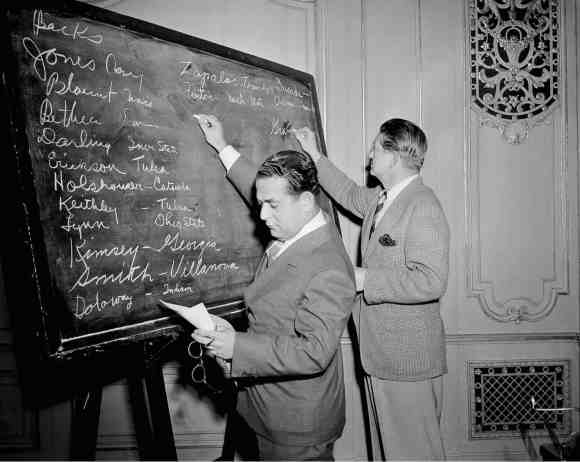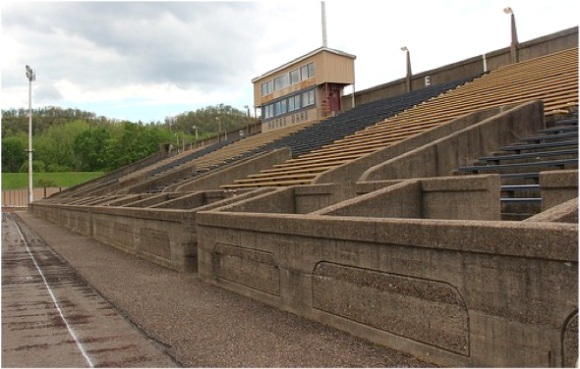 In 1943, Earl “Dutch” Clark resigned as the third head coach of the Cleveland Rams, ending his National Football League career under far less auspicious circumstances than had attended his highly successful entry to the league as an explosive back for the Portsmouth Spartans / Detroit Lions. The following is excerpted from the newly published book The Cleveland Rams: The NFL Champs Who Left Too Soon, 1936–1945, by James C. Sulecki.
In 1943, Earl “Dutch” Clark resigned as the third head coach of the Cleveland Rams, ending his National Football League career under far less auspicious circumstances than had attended his highly successful entry to the league as an explosive back for the Portsmouth Spartans / Detroit Lions. The following is excerpted from the newly published book The Cleveland Rams: The NFL Champs Who Left Too Soon, 1936–1945, by James C. Sulecki.
The Cleveland Rams were so confident they were on the cusp of something promising in 1939 that they scheduled every one of their National Football League home games for huge Cleveland Stadium, the yellow-bricked, tarnished-aluminum wonder on the city’s waterfront. Lying empty and locked on Sundays the autumn before, the stadium silently mocked the Rams as they played to small houses at Shaw High School in East Cleveland and at Cleveland’s League Park. But now the team had notches on its belt marked Chicago Bears and Detroit Lions, vanquished foes in 1938 who could testify that the Cleveland franchise, after only two seasons with the big boys, was capable of holding its own in the NFL. The Rams’ roster was studded with budding stars in backs Johnny Drake and Corby Davis; receiver Jim Benton; and rookie Parker Hall, a passer with great promise. And after several false starts the team was led by an experienced and championship-winning head coach in Earl “Dutch” Clark, who in turn was bolstered by a more than capable assistant in his predecessor Art “Pappy” Lewis. The Rams’ aspirations at last seemed equal to the Stadium in which they seemed destined to play.
But when Clark, in a suit and sporting a jaunty fedora, took his Rams to the stadium field on September 6, 1939 for his debut game as Rams head coach—a preseason 28–0 triumph over the Ohio College All-Stars—he likely felt the implicit expectations of the structure’s massive capacity. The crowd of 21,442 barely filled more than one-quarter of Cleveland Stadium’s seats. Clearly, Clark intuited, it was going to take a lot more player talent and on-field success to come even close to filling that grandstand. Until that day, the largely empty stadium would echo with unfulfilled promise. The ballpark’s playing surface, furthermore, was inordinately enormous. Clark no doubt would have nodded in recognition with Babe Ruth’s observation that “you’d have to have a horse to play outfield” there. Staging a game in the center of such a huge structure “made the players feel as if they were performing before empty stands,” Clark would say a few years later. Spectators were “just too far away, not only for themselves, but the players also.”

This was something quite new for Clark. University of Detroit Stadium, capacity 25,000 and home of his prior team the Lions, was more his accustomed habitat. But his pro career had begun in a venue even more humble than a university field. In 1930 Clark graduated from small Colorado College and came east to Ohio, to a Depression-stricken shoe-manufacturing town hard against the charging waters of the Ohio River and a stone’s throw from Kentucky. The Portsmouth Spartans’ Universal Stadium (above, photographed in spring 2014) was a brusquely art deco edifice of grand archways and graceful curves, of special grandstand boxes and obelisk-shaped light standards, but it held only 8,200 at its capacity. This did not deter the Spartans from tearing through the young NFL as one of the powerhouse teams of their era—runners-up to the Bears as league champions in 1932 before they broke through with their own title as the renamed Detroit Lions in 1935. Like future Ram Bob Waterfield, Clark wore number 7, became the highest-paid player in the league, and eventually was inducted into the Pro Football Hall of Fame. But never in his many circuits through the NFL had he played in a venue quite the size of Cleveland Stadium, nor had he been handed a shortage of talent such as he had inherited with the woebegone Rams …
__________
Dutch Clark had enough. Enough losing. Enough frustration. Rams owners Daniel F. Reeves and Fred Levy Jr. wanted him back as head coach for the 1943 season, but after the holidays Clark allowed his contract to expire and returned home to Colorado Springs. Then on March 10, 1943 he sent word to the Cleveland Plain Dealer that he had “advised Mr. Reeves not to consider renewal of my contract due to uncertain conditions. Possibilities elsewhere seem greater.” It was cryptic, but Clark definitely was through. He never was much of a believer in the pro game; he thought most players peaked in their junior years in college and rarely improved after that. He confided to friends that he “found the coaching job irksome”and greatly missed his playing days with the Spartans and Lions. But perhaps as much as anything he despaired of the Rams ever truly challenging the Bears and Green Bay Packers for the Western Division title. With a final overall record of 16-26-2 he bowed out of the Rams’ head coaching position under his own power rather than be removed against his will as his predecessors Lewis and Hugo Bezdek had been. He recommended Charles “Chile” Walsh as his replacement, then departed for military service. Beyond his pickup of free agent Riley “Rattlesnake” Matheson, his “ultimate failure in Cleveland came down to his inability to draft good players,” wrote Clark biographer Chris Willis. Like Lewis and Bezdek—indeed like Rams founder Damon “Buzz” Wetzel before them—Clark never coached in the NFL again …
© 2016 James C. Sulecki





 The National Football League was founded in 1920 in Canton, 60 miles south of Cleveland down the Cuyahoga River valley, just past Akron and the overland portage that links the Cuyahoga with the Tuscarawas River.
The National Football League was founded in 1920 in Canton, 60 miles south of Cleveland down the Cuyahoga River valley, just past Akron and the overland portage that links the Cuyahoga with the Tuscarawas River.



